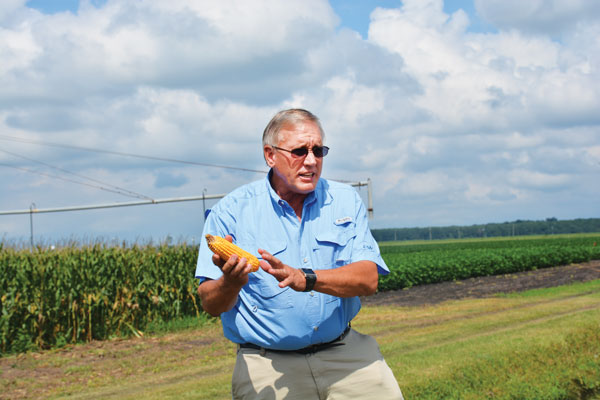
North Carolina Extension corn specialist Ron Heiniger encourages farmers to think about doing things differently in order to achieve the top yields he suggested they should aim for at this summer’s Blackland Farm Managers Tour.
Like many agronomists across the South and in the Midwest, Heiniger believes average yields of 300 bushels per acre are achievable.
Some growers in the South are already hitting whole-farm yields of 240 bushels-plus per acre now.
So how do you get to the next level of 300 bushels per acre?
Managing three things — sunlight, water and nitrogen — is critical, says Heiniger, who spoke at the the Vernon G. James Research & Extension Center in Plymouth during the tour.
Other important factors
“If you are thinking about the factors that lead to 300-bushel corn, those are the three key ones,” Heiniger says. “How you get there depends on your environment, your soil, your capability, and your management of what you have to work with.
“First, you have to manage sunlight — capture the maximum amount of sunlight for the maximum amount of time. That means getting the crop up and intercepting sunlight quickly, then keeping the crop intercepting sunlight as long as possible.
“Second, you have to manage water. You need good moisture on a consistent basis.
“Third, you have to manage nitrogen. We need for the corn plants to have lots and lots of chlorophyll. It’s the energy mechanism for the plants.
“And how do we make more chlorophyll? The simple answer is, you need more nitrogen because nitrogen is a critical component of that molecule.”
High 200s yield
Last year, Heiniger got close to producing 300 bushels per acre in a number of his trials, achieving yields into the high 200 bushels range in many locations.
“We increased yield significantly a number of times, so we are at least on the right track,” he says. “We may not have made our goal, but at least we took the right steps toward that goal.”
In 2012, however, Heiniger did achieve 300 bushels per acre in trials in Pamlico and Pasquotank Counties.
“We had a number of 300-bushel yields from different hybrids and different management systems,” he says.
A key to achieving 300 bushels in those counties that year was season-long nitrogen availability, he says.
Management comparisons
At the Blackland Tour, Heiniger shared results of his yield trials from 2013 in Beaufort, Pamlico, Davidson and Sampson Counties, where he used both intensive management practices and standard management practices.
His top performance last year was 267.7 bushels per acre in Pamlico County, using intensive management practices.
In the standard practice trials, he planted 33,000 plants per acre, used no fungicide, used no early season nitrogen and used no Pentiliex seed treatment.
In his intensive management trials, he planted 43,000 plants per acre, applied fungicide, applied early season nitrogen and used a Pentiliex seed treatment.
Heiniger says increasing the plant population from 33,000 plants per acre to 43,000 plants per acre is one way of achieving the goal of getting more sunlight.
“Changing your plant population does that. You can significantly increase yield by using a higher population.”
Get to canopy
In his trials, Heiniger included the seed treatment Pentiliex in order to get the corn off to a good start.
“There are two reasons for this,” he says. “Number one, you want to canopy as soon as possible. The faster you get corn to canopy, the faster you are capturing all of the sunlight you can capture.
“The second thing you do when you get early growth is, you make roots. Over the years we have seen the advantage of going with starter fertilizer.”
In addition to managing sunlight, water and nitrogen, Heiniger says, hybrid selection is critical.
Some farmers may want to plant “offensive” hybrids with higher yield potential, while others may want to plant hybrids with drought protection and stress tolerance, Heiniger says.
Select best possible hybrid
“If I were thinking about making 300 bushels per acre, I would consider what would be the best hybrid I could plant that would get me to that goal?
“Do I need one that’s going to be a little more offensive and maybe not tolerate stress as well? Or do I need at least some stress tolerance, if I’m going to reach that goal? It depends on whether you have irrigation and how much water your soil holds.”
It is certainly critical to factor in the costs of achieving 300 bushels per acre, Heiniger says. But by selecting the right hybrid, increasing plant population and making the best use of sunlight, water and nitrogen throughout the season, farmers can make great strides toward reaching that goal.
“If I could lead you through those plots, and you could see what 300-bushel corn looks like, you would be impressed with what you see,” Heiniger says.
“If you get a chance to combine 300-bushel corn, it’s like combining water. — it literally comes through that combine like flowing water.”
About the Author(s)
You May Also Like






